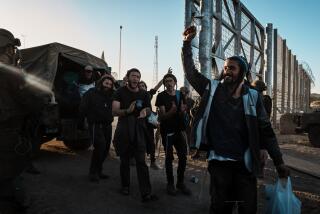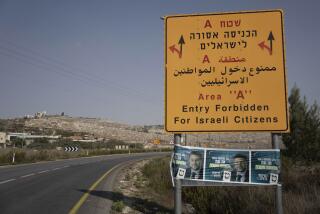Future of vast Jewish enclave in West Bank far from settled
- Share via
Reporting from Ariel, West Bank — Ron Nachman had waited 10 months for this day. But when Israel’s West Bank construction moratorium expired a week ago and settlers celebrated with balloons and bulldozers, the mayor of the fourth-largest Jewish settlement was nowhere to be found.
Nachman, 68, was in the hospital undergoing chemotherapy for recently diagnosed bladder cancer.
It was a bitter twist of fate for the hard-charging founder of Ariel and one of Israel’s most outspoken proponents of Jewish expansion in the West Bank. Since the day 32 years ago when he pitched a tent near some Palestinian villages 12 miles beyond Israel’s border, Nachman has spent his career building a settlement that he hoped would become too big to give up.
Now, as he fights for his life, Nachman also faces what could be the ultimate challenge to Ariel.
With Israel’s renewed settlement construction threatening to torpedo U.S.-sponsored peace talks, there’s a growing call for negotiators to focus on establishing permanent borders for a future Palestinian state. Once borders are set, the settlement dispute becomes moot because Israel will know where it can build and where it should not.
That means it’s crunch time for Ariel, a settlement deep inside the West Bank that the U.N. and international community consider illegal.
Despite Nachman’s efforts, there’s still no clear consensus, either among Israelis or Palestinians, about whether Ariel will be absorbed into Palestinian territory or remain part of Israel. Over the years, some peace plans have put Ariel within Israel, others called for its evacuation. Because of its size, nearly 17,000 people, many assume Ariel and the other large settlement blocks will become part of Israel. But that could prove difficult for Ariel, an island of Jewish residency surrounded by Palestinian land.
Palestinians complain that Ariel isolates about seven Palestinian villages, partially divides the northern West Bank and sits atop a coveted water supply. Some Israelis also question whether Ariel is worth keeping, spurring a group of Israeli artists last month to announce a boycott of the settlement’s soon-to-open performing arts center.
If Israel wants to keep Ariel and the long strip of land needed to access the city, it remains unclear how much Israel will have to give up in terms of land swaps, and whether the Israeli public, or even Ariel’s residents, will deem it worth the price. Over the last decade, many residents have been voting with their feet. Unlike in other large settlements, people often are moving out more quickly than they are moving in, government statistics suggest.
“Why would anyone in their right mind want to live there when they realize how far away it is and that they’d be surrounded by a Palestinian state?” says Akiva Eldar, a Haaretz newspaper columnist who describes Ariel as a “finger in the eye” of a future Palestinian state.
To Nachman, there is no question that Ariel will remain part of Israel.
“It’s not a settlement. It’s a city that is key to the future of Israel,” he says. “Show me the government that would give it up.”
Just the same, he acknowledges that the nagging question over Ariel’s future energizes him to keep fighting.
“This is my life’s mission,” he said during an interview in his office, back at work just hours after chemo and following a close call with kidney failure. “Now I need to protect the city that I built.”
Like a proud father, he pulls out a well-worn photo album and begins thumbing through the pages. Here’s Nachman sporting 1970s sideburns and a turtleneck, on the rocky terrain amid camels. There are early settlers carrying water by buckets.
“See, here I am,” says Nachman, the fourth generation in a line of Israeli-born Zionists. Though non-observant, Nachman says the Holy Land, including the West Bank, was given to the Jewish people by God. He once tried to force Palestinian workers in Ariel to wear badges until critics compared them to the yellow stars forced upon Jews by the Nazis.
As Ariel’s first and only elected mayor — now in his sixth term — Nachman has been a tireless cheerleader and promoter of the settlement.
In the 1990s, he doubled Ariel’s population by personally flying to Moscow to attract Russian immigrants because official Jewish resettlement agencies were reluctant to move newcomers to the West Bank. (Some Russian families later lamented that no one told them they’d be moving onto disputed land.) With financial help from many U.S. Jewish and Christian groups, Nachman later campaigned to give Ariel infrastructure and institutions rarely seen in settlements, including a university, sports center, resort hotel, industrial park and the new $8-million performing arts center.
Over the years, he’s constantly reinvented and rebranded Ariel. First there was the Russian influx. Then it was a college town and a WiFi-wired “smart” city. In recent years, he’s tried to turn Ariel into an English-speaking enclave, seeking Jewish immigration from the U.S. and Canada.
And he moved to expand the predominantly secular city to include more religious families, welcoming a community of die-hard settlers who were forced to evacuate the Gaza Strip during the 2005 disengagement. They were the first to break ground last week on new homes after the moratorium ended.
“Everything you see in Ariel today is exactly as I wrote it would be in 1978,” he says. “Not many people have the chance to build a city from scratch.... As Frank Sinatra says, I did it my way.”
Of course, Nachman’s romantic narrative about Ariel’s rise isn’t shared by Palestinians, who view him a colonizer. Ariel eats up nearly 2 square miles of land, and sits atop one of the region’s largest underground water reservoirs.
“He speaks as if this was his land, but most of it was confiscated from Palestinians,” says Khalil Tufakji, a Palestinian cartographer and expert on Jewish settlements. “Now Palestinians can’t build there. This came from our flesh and blood.”
He says Palestinian Authority negotiators have expressed a willingness to talk about allowing Ariel to remain part of Israel, but it would require land swaps of equally valuable territory and agreements that Ariel could not expand further. He was skeptical about whether Nachman would agree.
“This mayor will have to return home and retire, and give the process to the people who believe in peace,” he said.
Nachman says he believes in coexistence and notes that he hired a Palestinian city engineer. At the same time he makes no secret of his disdain for peace talks and opposition to a two-state plan, suggesting that Jordan and Israel divvy up the West Bank.
Much of the money to fulfill his dream has come from U.S. evangelicals, many of whom view Israel’s ascension in the West Bank and Jerusalem as divine prophecy. Ariel’s sport center, for example, is named after Texas minister John Hagee.
Although Nachman canceled a fundraising trip to Southern California this month, he’s usually greeted like a rock star on the Christian talk circuit.
“I’m like a preacher in the church,” he says. “Do you know how many Christians pray for me every day? Thousands. They love me.”
Nevertheless, Nachman’s ambitions for Ariel have not gone exactly as planned. Over the last decade the population has been essentially stagnant, growing less than 1% annually, despite the cheaper housing, tax breaks, mortgage subsidies and other financial benefits settlers enjoy.
By contrast, other large settlements, such as Beitar Illit and Modiin Illit, which were about the same size as Ariel in 2000, have doubled in population. Maale Adumim, another large secular settlement city, grew more than 30%.
“Ariel is more of a myth than a real success story,” says Hagit Ofran, a spokeswoman for Peace Now, an Israeli group that opposes settlements.
Nachman blames the government for imposing sporadic construction freezes, including the 10-month moratorium that just ended.
But he acknowledges that market forces are also at work. He says Ariel has government approval for 3,000 new housing units, but even before the recent moratorium, construction was put off for lack of demand.
“You need to create certainty, and people have many doubts and wonder if they should invest in a place where building may be frozen again,” he says.
Even some of Ariel’s residents seem ready to throw in the towel, as long as they receive compensation.
“So give it back,” says Eli Lalazar, 56, who has lived in Ariel for 28 years. His children, now grown, have already moved away because they didn’t see a future in Ariel. “If it brings peace, why not?”
Nachman blames the U.S. government and leftist Israeli groups for fostering such doubts and predicts Ariel’s residents will fight for their city.
“You know the fight of Alamo,” he said. “Ariel is Alamo.”
When asked if that was the best analogy, given that the Mexican army defeated Texas settlers trying to defend the Alamo, Nachman pauses for a moment.
“All right,” he says. “Ariel is Ft. Knox.”
edmund.sanders@latimes.com
More to Read
Sign up for Essential California
The most important California stories and recommendations in your inbox every morning.
You may occasionally receive promotional content from the Los Angeles Times.










